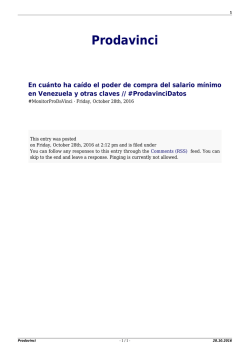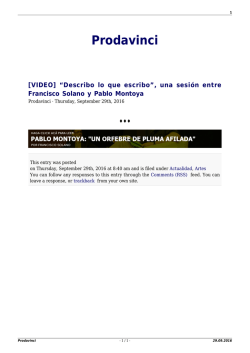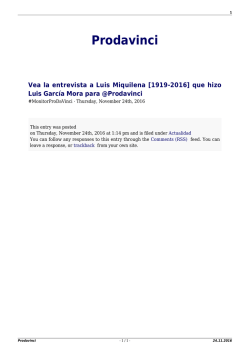
1 in 5 unemployed persons in the EU found a job
233/2016 - 25 November 2016 Second quarter 2016 compared with first quarter 2016 1 in 5 unemployed persons in the EU found a job Out of all persons in the European Union (EU) who were unemployed in the first quarter 2016, 63.2% (12.6 million persons) remained unemployed in the second quarter 2016, while 19.5% (3.9 million) moved into employment and 17.3% (3.5 million) towards economic inactivity. Economically inactive individuals are those neither employed nor unemployed. Examples are students, pensioners and housewives or -men, provided that they are not working at all and not available or looking for work either. Of all those initially in employment, 97.3% (170.8 million persons) remained in employment, while 1.2% (2.0 million) of those employed in the first quarter 2016 were observed to be unemployed in the second quarter 2016, and 1.6% (2.7 million) transitioned into economic inactivity. Of all those initially in economic inactivity, 93.3% (106.1 million persons) remained in inactivity, while 6.7% entered the labour market: 3.1% (3.6 million) of those inactive in the first quarter 2016 moved into employment in the second quarter 2016, and 3.6% (4.1 million) transitioned into unemployment. Today, Eurostat, the statistical office of the European Union, publishes quarterly labour market flows, based on non-seasonally adjusted labour market data from the European Union Labour Force Survey. Transitions in labour market status in the EU*, Q1 2016-Q2 2016 (in millions; population aged 15-74) * The graphic gives an overview of all possible transitions and shows the aggregate transitions for 26 EU Member States between the different labour market statuses. Data is shown in absolute numbers. The levels indicated for employment, unemployment and inactivity refer to the share remaining in each status between the two quarters, respectively. The grey arrows indicate the direction of net flows. Transitions in labour market status in the EU*, Q1 2016-Q2 2016 (in % of initial status; population aged 15-74) TO FROM Employment Q2 2016 Unemployment Q2 2016 Inactivity Q2 2016 Employment Q1 2016 97.3% 1.2% 1.6% Unemployment Q1 2016 19.5% 63.2% 17.3% Inactivity Q1 2016 3.1% 3.6% 93.3% * EU aggregate based on 26 Member States. Labour market flows show the movements of individuals between employment, unemployment, and economic inactivity and enrich the analysis of the net changes in stocks. In particular, outflows from unemployment yield insights into the degree of flexibility or rigidity of the labour market, especially when combined with data on the stock of unemployment in each Member State. Four stylized situations can be distinguished, and the combination of the unemployment rate and the probability of transitioning into employment determines the location on the spectrum. Member States with relatively low unemployment and high transitions into employment - Examples are Denmark, Estonia or Sweden Member States with relatively high unemployment and high transitions into employment - Examples are Cyprus, Croatia or Portugal Member States with relatively high unemployment and low transitions into employment - Examples are Greece, Spain or Italy Member States with relatively low unemployment and low transitions into employment - Examples are Romania, Bulgaria or Ireland Unemployment rate Q1 2016 and transition from unemployment to employment Q1 2016-Q2 2016 (transition in % of initial status; population aged 15-74) Transition into employment, % Estonia Denmark 36 Sweden 31 Finland Cyprus Malta Netherlands Austria Hungary 26 Slovenia France Portugal Czech Republic Poland EU United Kingdom 4 Luxembourg Croatia 21 Unemployment rate, % Latvia 9 14 19 Spain 24 Italy Lithuania 16 Ireland Slovakia Bulgaria Romania 11 Greece 6 Quarterly data on labour market flows not available for Belgium and Germany. Outflow from unemployment, Q1 2016-Q2 2016, compared to same flow each year since 2011 (in % of unemployed persons aged 15-74 in initial quarter) Into employment in Q2 2011 Q2 2012 Q2 2013 Q2 2014 Q2 2015 Q2 2016 18.2% 16.5% 16.0% 17.1% 18.7% 19.5% Belgium : : : : : : Bulgaria 10.6% 10.4% 13.0% 14.5% 10.7% 11.9% Czech Republic 19.7% 19.1% 18.5% 21.9% 22.2% 21.9% Denmark 37.2% 29.7% 39.8% 34.7% 38.4% 36.6% Germany : : : : : : Estonia 15.5% 21.6% 25.8% 31.3% 29.2% 36.9% Ireland 11.2% 9.8% 11.0% 10.7% 16.4% 15.0% Greece 4.6% 2.2% 5.0% 7.4% 8.6% 8.6% Spain 18.8% 14.6% 13.9% 16.0% 17.9% 18.4% France 24.2% 21.8% 22.1% 21.7% 22.9% 22.8% Croatia EU* 7.9% 13.8% 12.4% 14.4% 16.3% 21.6% Italy 17.7% 17.4% 12.7% 13.2% 16.1% 17.4% Cyprus 31.8% 18.6% 15.8% 18.9% 21.1% 27.7% Latvia 20.9% 21.6% 19.3% 20.8% 24.0% 20.4% Lithuania 12.3% 15.6% 17.7% 18.2% 18.6% 17.1% : : : : 17.2% 18.2% 17.2% 16.7% 22.6% 19.8% 23.1% 24.4% - - - - - 24.7% Netherlands 24.8% 22.9% 20.9% 20.4% 21.9% 25.3% Austria 37.1% 28.8% 32.2% 27.3% 26.3% 25.1% Poland 15.9% 14.9% 15.1% 17.0% 15.8% 20.5% Portugal 22.1% 17.6% 16.7% 20.7% 25.0% 22.4% Romania 12.3% 11.3% 14.2% 11.2% 17.7% 11.6% Slovenia 21.0% 21.3% 16.8% 20.9% 19.3% 25.8% Slovakia 9.3% 7.8% 7.6% 9.0% 13.4% 15.1% Finland 32.5% 30.0% 31.6% 28.7% 25.6% 28.7% Sweden 29.6% 28.4% 29.0% 30.9% 29.6% 31.3% United Kingdom 14.8% 18.4% 16.6% 18.8% 18.8% 19.5% Iceland 33.8% 41.4% 38.2% 39.1% 48.1% 58.8% Norway 30.1% 33.6% 30.0% 28.5% 26.6% 24.0% Switzerland 38.2% 35.4% 33.8% 33.2% 34.8% 33.2% 9.0% 8.0% 10.3% 9.9% 15.6% 16.9% 41.6% 42.3% 39.9% 42.0% 40.0% 35.5% Luxembourg Hungary Malta FYR of Macedonia Turkey * EU aggregate based on 26 Member States. : Data not available. - Data not published due to small sample size. Data marked in green show an improvement compared with the same quarter of the previous year, those marked in red show deterioration. The source dataset can be found here. Geographical information Data for the European Union (EU) presented in this news release cover 26 out of the 28 Member States: Bulgaria, the Czech Republic, Denmark, Estonia, Ireland, Greece, Spain, France, Croatia, Italy, Cyprus, Latvia, Lithuania, Luxembourg, Hungary, Malta, the Netherlands, Austria, Poland, Portugal, Romania, Slovenia, Slovakia, Finland, Sweden and the United Kingdom. Data are not available for Belgium and Germany. For Belgium, data are expected to become available from Q1 2017 onwards. For Germany, data are expected to become available from Q1 2019 onwards. Methods and definitions In order to ensure comparability, data published by Eurostat are based on a harmonised methodology. This may result in small differences between these data and those published nationally. Data are derived from the EU-LFS by exploiting the quarterly overlap of a share of the sample; this overlapping data is weighted to be compatible with stock data derived from the EU-LFS for the initial quarter as well as the final quarter with the exception of inactivity in the initial quarter. Further information on the methodology is available in the Eurostat Statistics Explained article on labour market flow statistics. Employed persons are all persons who worked at least one hour for pay or profit during the reference week or were temporarily absent from such work. Unemployed persons are all persons who were not employed during the reference week, had actively sought work during the past four weeks, and were ready to begin working immediately or within two weeks. The inactive population consists of all persons who are classified neither as employed nor as unemployed. It can include in particular students, pensioners and housewives or -men, for example, provided that they are not working at all and not available or looking for work either; some of these may be of working-age. Revisions and time table Data in this news release have a provisional nature and can be subject to revisions due to improvements and refinements in the methods used. For more information Eurostat database on labour market statistics. Eurostat metadata on labour market transitions. Eurostat Statistics Explained article on labour market flow statistics in the EU. Issued by: Eurostat Press Office Production of data: Vincent BOURGEAIS Tel: +352-4301-33 444 [email protected] Frank ESPELAGE Tel: +352-4301-37 406 ec.europa.eu/eurostat @EU_Eurostat Hannah KIIVER Tel: +352-4301-38 438 [email protected] Media requests: Eurostat media support / Tel: +352-4301-33 408 / [email protected]
© Copyright 2025







